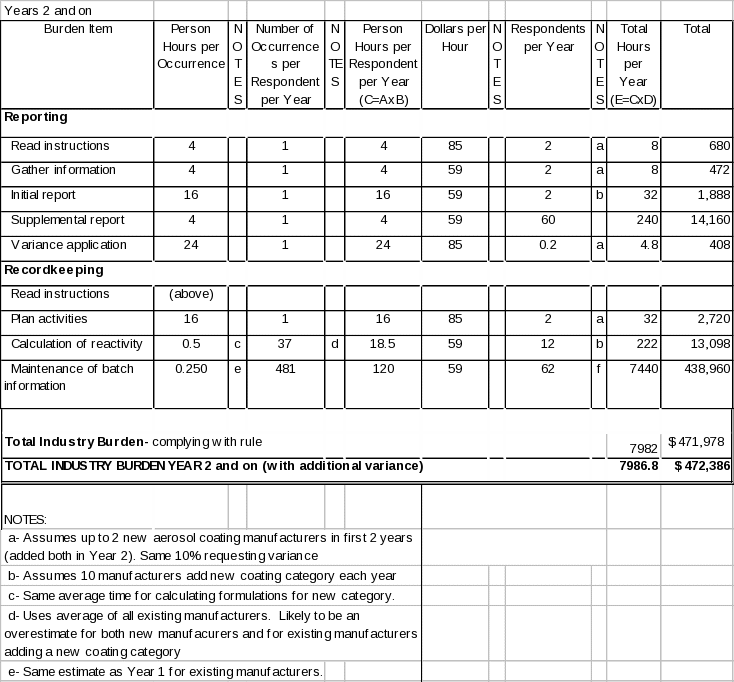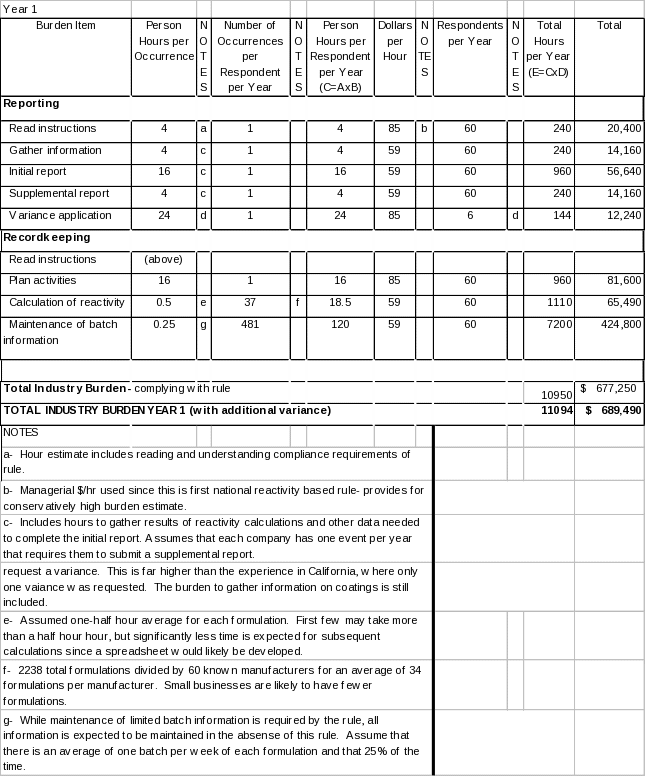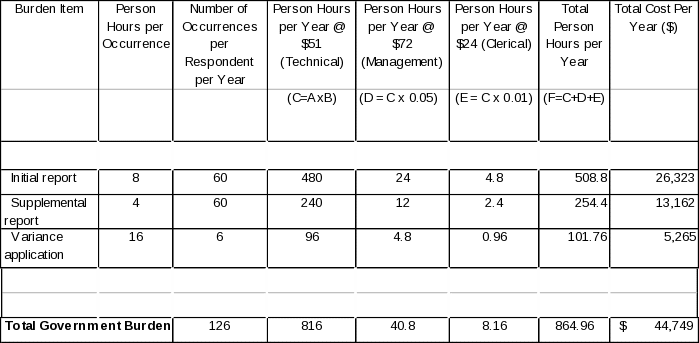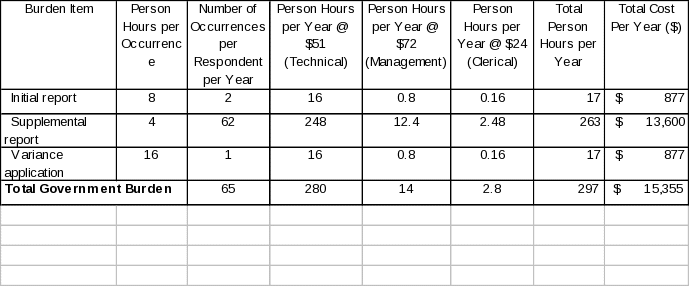2266ss01
2266ss01.doc
National Volatile Organic Compound (VOC) Emission Standards for Aerosol Coatings (40 CFR part 59, subpart E) (Proposed Rule)
OMB: 2060-0604
Part A OF THE SUPPORTING STATEMENT
1. Identification of the Information Collection
(a) Title and Number of Information Collection.
“National Volatile Organic Control Emission Standards for Aerosol Coatings (40 CFR part 59, subpart E) (Proposed Rule).” The Environmental Protection Agency (EPA) tracking number for this information collection request (ICR) is 2266.01. This is a new ICR.
(b) Short Characterization
(i) Type of collection.
This information collection includes initial reports and periodic recordkeeping necessary for the EPA to ensure compliance with the federal standards for aerosol coatings. Respondents include manufacturers, wholesale distributors, processors, and importers of aerosol coatings for sale or distribution in interstate commerce in the United States.
(ii) Content of reports.
All respondents must submit an initial notification report 90 days before the compliance date. This report will provide basic information about the regulated entity and will identify all manufacturers, processors, wholesale distributors, or importers of aerosol coatings. In addition, this report will need to explain the date code system used to label products and it must include a statement certifying that all of the company’s products will be in compliance with the limits by the compliance date.
There are no regular, ongoing reporting requirements for most regulated entities. Reporting after the initial compliance report is only required when a manufacturer adds a new coating category.
Small manufactures that qualify for exemption from the limits of the rule are required to make an annual report to EPA providing necessary information and documentation to establish that the products made by the entity should be exempt.
Respondents submit a written application to the Agency requesting a temporary variance if, for reasons beyond their reasonable control, they cannot comply with the requirements of the rule. An approved variance order would specify a final compliance date and a condition that imposes increments of progress necessary to assure timely compliance. A variance would end immediately if the regulated entity failed to comply with any term or condition of the variance.
The rule includes labeling requirements to facilitate implementation and enforcement of the limits. Labels must clearly identify the product category or the category code, the limit for that category, and the product date code. If the date code is not easily discernable, an explanation of the code would need to be included in the initial notification report.
(iii) Recordkeeping Requirements
Respondents are required to maintain compliance calculations for each of its aerosol coatings formulations. For each batch of a particular formulation, the regulated entity must maintain records of the date(s) the batch was manufactured, the volume of the batch, and the VOC formula for the formulation. Records of these calculations must be maintained 5 years after the product is manufactured, processed, distributed for wholesale, or imported for sale or distribution in interstate commerce in the United States.
2 Need for and Use of the Collection
(a) Need/Authority for the Collection.
The EPA is charged under section 183 (e) of the Clean Air Act (CAA), as amended, to establish emission standards for aerosol coatings. The national volatile organic compound (VOC) emission standards for aerosol coatings (40 CFR Part 59, subpart E) are being proposed. We developed the proposed action pursuant to the requirements of section 183(e) of the Clean Air Act (CAA).
Section 183(e) of the CAA requires EPA to regulate consumer or commercial products that account for at least 80 percent of the VOC emissions, on a reactivity-adjusted basis, in areas that violate the national ambient air quality standards for ozone. The CAA also directs EPA to divide the consumer or commercial products into four groups, and establish priorities for regulation until all 4 groups are regulated. Of the 22 source categories identified and divided into four groups, the aerosol coatings source category is in Group III, and is currently slated for regulation. When these proposed standards are final, regulated entities will have to comply with recordkeeping and reporting requirements of the new rule.
The information collection requirements are based on recordkeeping and reporting requirements. These recordkeeping and reporting requirements are specifically authorized by CAA section 114 (42 U.S.C. 7414). All information submitted to EPA pursuant to the recordkeeping and reporting requirements for which a claim of confidentiality is made is safeguarded according to Agency policies set forth in 40 CFR part 2, subpart B. Initial notifications and reports, as described in this information collection request, are necessary to enable the Administrator to determine if the standards are being achieved. The emission standards require an initial notification report from all regulated entities to EPA 90 days before the compliance date. The regulated entity is required to maintain compliance calculations for each of its aerosol coatings formulations. Records of these calculations must be maintained 5 years after the product is manufactured, processed, distributed for wholesale, or imported for sale or distribution in interstate commerce in the United States. The retention of records for 5 years would allow EPA to establish the compliance history of a regulated entity and any pattern of compliance for purposes of determining the appropriate level of enforcement action. Historically, EPA has found that the most flagrant violators frequently have violations extending beyond the 5 years. The EPA would be prevented from pursuing the worst violators due to the destruction or nonexistence of records, if records were retained for less than 5 years.
Respondents seeking a variance are required to submit an application which includes the grounds upon which the variance is being sought, the proposed date for coming into compliance, and a plan for achieving compliance.
(b) Practical Utility/Users of the Data.
Agency enforcement personnel will use the information collected to (1) identify regulated entities subject to the rule; and (2) ensure that aerosol coatings comply with the product weighted reactivity limits. These activities are essential to compliance assurance.
3. Nonduplication, Consultations, and Other Collection Criteria
(a) Nonduplication
The subject emission standards are delegated to the EPA and information is sent directly to the appropriate EPA Regional Office. EPA has not duplicated the recordkeeping and reporting requirements for regulated entities that may be subject to the proposed rule covered under this ICR.
(b) Public Notice Required Prior to ICR Submission to OMB
A public notice of this collection will be provided in the notice of proposed rulemaking for the national VOC emission standards for aerosol coatings.
(c) Consultations
During the development of this rule, EPA consulted with the State of California, industry, and a trade association in order to obtain an industry description and information on the aerosol coatings market, and to obtain information on associated aerosol coatings costs. Also, EPA conducted searches of potential regulated entities to obtain information on the universe of potentially affected entities. The public will have an opportunity to review and comment on the proposed rule and ICR during the specified comment period.
Table 1. Consultations
Pat Gieske |
Seymour of Sycamore |
Gregory L. Johnson |
The Sherwin Williams Company |
Jim Johnson |
The Sherwin Williams Company |
Ed Piszynski |
Hydrosol, Inc. |
Heidi K. McAuliffe |
National Paint and Coatings Assoc. |
Doug Raymond |
Doug Raymond Associates |
State of California |
Air Resources Board |
Ed Laird |
Coatings Resource Corp. |
(d) Effects of Less Frequent Collection
The proposed rule includes an initial compliance report from regulated entities affected by this rule. Reporting after the initial compliance report is only required when a manufacturer adds a new coating category. Less frequent information collection would decrease the margin of assurance that the facilities are continuing to meet the proposed standards.
(e) General Guidelines
This ICR adheres to the guidelines for Federal data requesters, as provided at 5 CFR 1320.6. Initial notifications and reports, as described in this information collection request, are necessary to enable the Administrator to determine if the standards are being achieved. The emission standards require an initial notification report from all regulated entities to EPA 90 days before the compliance date. The regulated entity is required to maintain compliance calculations for each of its aerosol coatings formulations. Records of these calculations must be maintained 5 years after the product is manufactured, processed, distributed for wholesale, or imported for sale or distribution in interstate commerce in the United States. The retention of records for 5 years would allow EPA to establish the compliance history of a regulated entity and any pattern of compliance for purposes of determining the appropriate level of enforcement action. Historically, EPA has found that the most flagrant violators frequently have violations extending beyond the 5 years. The EPA would be prevented from pursuing the worst violators due to the destruction or nonexistence of records, if records were retained for less than 5 years.
(f) Confidentiality
All information submitted to EPA for which a claim of confidentiality is made will be safeguarded according to EPA policies set forth in title 40, chapter 1, part 2, subpart B – Confidentiality of Business Information (see 40 CFR 2; 41 FR 36902, September 1, 1976, amended by 43 FR 39999, September 28, 1978; 43 FR 42251, September 28, 1978; 44 FR 17674, March 23, 1979). 3(g) Sensitive Questions
This section is not applicable because this ICR does not involve matters of a sensitive nature.
4. The Respondents and the Information Requested
(a) Respondent/NAICS Codes
Respondents to this information collection are manufacturers, processors, distributors, and importers of aerosol coatings. These regulated entities fall within, and may not be limited to, the North American Industry Classification System (NAICS) Code 32551, "Paint and Coating Manufacturing" and NAICS Code 325998 "All Other Miscellaneous Chemical Production and Preparation Manufacturing".
(b) Information Requested
(i) Data items. Beginning January 1, 2009, regulated entities are required to maintain records of the following for each product subject to the product-weighted reactivity limits:
Recordkeeping
Product category;
All product calculations;
The product-weighted reactivity;
Weight fraction of all ingredients including water, solids, each VOC, and any compounds assigned a reactivity factor of zero; and,
A copy of each notification submitted, the documentation supporting each notification, and a copy of the label for each product.
Reporting
Initial report;
Supplemental report; and,
Variance application (if applicable).
(ii) Respondent activities.
The required respondent activities for new and existing manufacturers and importers of regulated products are listed in Tables 2 and 3. Both new and existing sources must read the rule and understand the rule requirements. Respondents must also submit notifications and supplemental reports according to the requirements specified in the rule. Each source must maintain all applicable records for 5 years.
5. The Information Collected: Agency Activities, Collection Methodology, and Information Management
(a) Agency Activities
A list of Agency activities is provided in Table 4.
(b) Collection Methodology Management
Reports submitted to the Agency and records maintained by the regulated entities may be tabulated and published for use in compliance and enforcement programs.
(c) Small Entity Flexibility
Affected entities are primarily small businesses. Because of the large number of small businesses that are likely to be affected by this rule, the reporting requirements for the individual regulated entities are minimal. There are no quarterly or semiannual requirements as there are with most regulated large entities. Reporting after the initial notification is only required if the facility makes changes in its operations or contact information. The burden is further minimized, since neither costly monitoring equipment, nor performance testing is required. Under the rule, there are no specific provisions for small-entity flexibility. Companies subject to the rule can apply for variances in cases where the company, because of extraordinary reasons beyond reasonable control, cannot comply with the rule. While all variance applications will receive close scrutiny, EPA will give full consideration to the special needs of small manufacturers and importers.
(d) Collection Schedule
The specific frequency for each information collection activity within this request is shown in Table 2.
6. Estimating the Burden and Cost of the Collection
Tables 2 through 4 document the individual burden items for the recordkeeping requirements resulting from the proposed action. The individual burdens are expressed under standardized headings consistent with the concept of burden under the Paperwork Reduction Act. Where appropriate, specific tasks and major assumptions have been identified. Responses to this information collection are mandatory. An agency may not conduct or sponsor, and a person is not required to respond to, a collection of information unless it displays a currently valid OMB Control Number.
(a) Estimating Respondent Burden.
The total annual burden to industry in year 1 from these recordkeeping and reporting requirements of the proposed action is estimated to be 11,000 hours (Total Hours per Year from Table 2). Each year thereafter, the burden is estimated to be 8,000 hours (Total Hours per Year from Table 3).
(b) Estimating Respondent Costs.
(i) Labor Costs - This ICR uses a base technical labor rate of $34.60 per hour. This rate was derived from estimates based on the EPA's experience with other standards. The wage was increased by 70 percent to account for the benefit packages and to account for overhead, which results in an hourly wage of $59.00 per hour. For several activities, we assumed a manager would complete certain tasks at a base rate of $50.00 per hour. The rate was increased by 70 percent to account for the benefit packages and to account for overhead, which results in an hourly wage rate of $85.00 per hour.
(ii) Capital/Startup and Operation and Maintenance Costs - No capital/startup and operation and maintenance costs are associated with this rulemaking.
(iii)Capital/Startup vs. Operation and Maintenance (O&M) Costs - No capital/startup and operation and maintenance costs are associated with this rulemaking.
(c) Estimating Agency Burden and Cost.
Because the information collection requirements were estimated as an incidental part of the standard development, no costs can be attributed to the development of the information collection requirements. Because reporting and recordkeeping requirements on the part of respondents are required under section 183(e) of the Act, no operational costs will be incurred by the Federal government. Examination of records to be maintained by the respondents will occur incidentally as a part of the periodic inspection of sources that is part of the EPA's overall compliance and enforcement program and is not attributable to this ICR. The only costs that the Federal government will incur are costs associated with the review of reported information, as presented in Table 4 and 5.
Labor rates and associated costs are based on Office of Personnel Management Table 2003-RUS. Overhead of 60 per cent was added, resulting in the following labor rates: management (GS15 - $72); technical (GS13 - $51); and clerical (GS7 - $24). The number of management hours is assumed to equal 5 percent of the number of technical hours; the number of clerical hours is assumed to equal 1 percent of the number of technical hours. (See Table 4.)
(d) Estimating the Respondent Universe and Total Burden Costs
The following assumptions were used to determine the respondent universe and total burden and costs for industry to comply with the various requirements of the rule:
The total number of regulated entities in Year 1 is 60;
Assumes 10 percent of respondents will request a variance;
Assumes each respondent will have one incident per year that will require supplemental reporting; and,
Total number of respondents in Years 2 and on will be 62, as follows (Assumes up to 2 new aerosol coating businesses will start up in the first 2 years (both added year 2 in cost estimate, 10% variance request rate; each respondent will have once incident per year that will require supplemental reporting, and each respondent will maintain records on 37 formulations (average for industry)).
(e) Bottom Line Burden Hours and Cost Tables.
(i) Respondent Tally
The bottom line respondent burden hours and cost for year 1, presented in Table 2, are calculated by summing all total costs for the reporting activities and the total costs for the recordkeeping activities. The bottom line respondent burden hours and cost for year 2 and beyond, presented in Table 3, are calculated by summing all total costs for the reporting activities and the total costs for the recordkeeping activities. The average annual burden and costs are 9,023 hours and $544,754.
(ii) Agency Tally
The bottom line Agency burden and costs are presented in Table 4. For year 1, the annual number of management hours is estimated to be 41 hours at $72.00 per hour; the annual number of technical hours is estimated to be 816 hours at $51.00 per hour; and the annual number of clerical hours is estimated to be 8 hours at $24.00 per hour. The total number of occurrences is estimated at 126, an estimate that includes completion of an initial report and supplemental report by each of the 60 regulated entities, plus a 10% variance application rate. Total annual Agency burden for year 1 is estimated to be 865 hours and $44,750.
The bottom line Agency burden and costs for year 2 and beyond are presented in Table 5. The annual number of management hours is estimated at 14 hours and $72.00 per hour; the annual number of technical hours is estimated at 280 hours and $51.00 per hour; and the annual number of clerical hours is estimated at 3 hours and $24.00 per hour. The total number of occurrences is estimated to be 65, which assumes 2 new initial reports, 4 supplemental reports, and 16 variance applications. Total annual Agency burden for year 2 and beyond is estimated to be 297 hours and $15,400.
The average annual cost to the federal government is $25,153.
(iii) Variations to the annual bottom line.
The EPA does not anticipate any significant annual variations to the bottom line after year 2 of the rule being in effect.
(f) Reasons for Change in Burden.
The year 1 burden estimate includes an initial number of respondents that will be required to perform recordkeeping and reporting activities, as outlined in the table below. Year 2 and beyond assumes 2 additional initial and supplemental reports will be required to be completed due to new aerosol coating product formulations being introduced into the market, or changes in existing aerosol coatings formulations. Year 2 and beyond burden estimates assume regulated entities will not require the level of management oversight required in year 1, due to experience gained by the technical staff. Therefore, less management hours are included in each of the annual burden estimates for year 2 and beyond.
(g) Burden Statement
The annual public reporting and recordkeeping burden for this collection of information is estimated to average 185 hours per respondent in year 1 and 129 hours per respondent in years 2 and 3.
Burden means the total time, effort, or financial resources expended by persons to generate, maintain, retain, or disclose or provide information to or for a Federal agency. This includes the time needed to review instructions; develop, acquire, install, and utilize technology and systems for the purposes of collecting, validating, and verifying information, processing and maintaining information, and disclosing and providing information; adjust the existing ways to comply with any previously applicable instructions and requirements; train personnel to be able to respond to a collection of information; search data sources; complete and review the collection of information; and transmit or otherwise disclose the information. An agency may not conduct or sponsor, and a person is not required to respond to, a collection of information unless it displays a currently valid OMB control number. The OMB control numbers for EPA's regulations are listed in 40 CFR part 9 and 48 CFR chapter 15.
To comment on the Agency's need for this information, the accuracy of the provided burden estimates, and any suggested methods for minimizing respondent burden, including the use of automated collection techniques, EPA has established a public docket for this ICR under Docket ID Number EPA-HQ-OAR-0971, which is available for online viewing at www.regulations.gov, or in person viewing at the Air and Radiation Docket and Information Center in the EPA Docket Center (EPA/DC), EPA West, Room 3334, 1301 Constitution Avenue, NW, Washington, D.C. The EPA Docket Center Public Reading Room is open from 8:30 a.m. to 4:30 p.m., Monday through Friday, excluding legal holidays. The telephone number for the Reading Room is (202) 566-1744, and the telephone number for the Air and Radiation Docket and Information Center is (202) 566-1742. An electronic version of the public docket is available at www.regulations.gov. This site can be used to submit or view public comments, access the index listing of the contents of the public docket, and to access those documents in the public docket that are available electronically. When in the system, select “search,” then key in the Docket ID Number identified above. Also, you can send comments to the Office of Information and Regulatory Affairs, Office of Management and Budget, 725 17th Street, NW, Washington, D.C. 20503, Attention: Desk Officer for EPA. Please include the EPA Docket ID Number EPA-HQ-2006-0971 and OMB Control Number 2060-NEW in any correspondence.
Table 2. Industry Recordkeeping and Reporting Costs Year 1
Table 3.Industry Recordkeeping & Reporting Costs Year 2

Table 4. Government Recordkeeping & Reporting Costs Year 1
Table 5. Government Recordkeeping & Reporting Costs Years 2 and Beyond
| File Type | application/msword |
| File Title | Abstract: |
| Author | Kaye Whitfield |
| Last Modified By | ckerwin |
| File Modified | 2007-07-16 |
| File Created | 2007-07-16 |
© 2025 OMB.report | Privacy Policy


